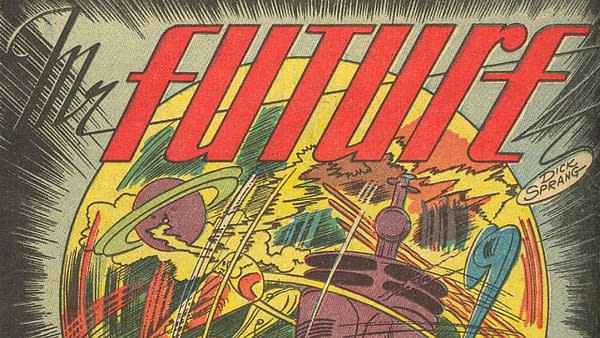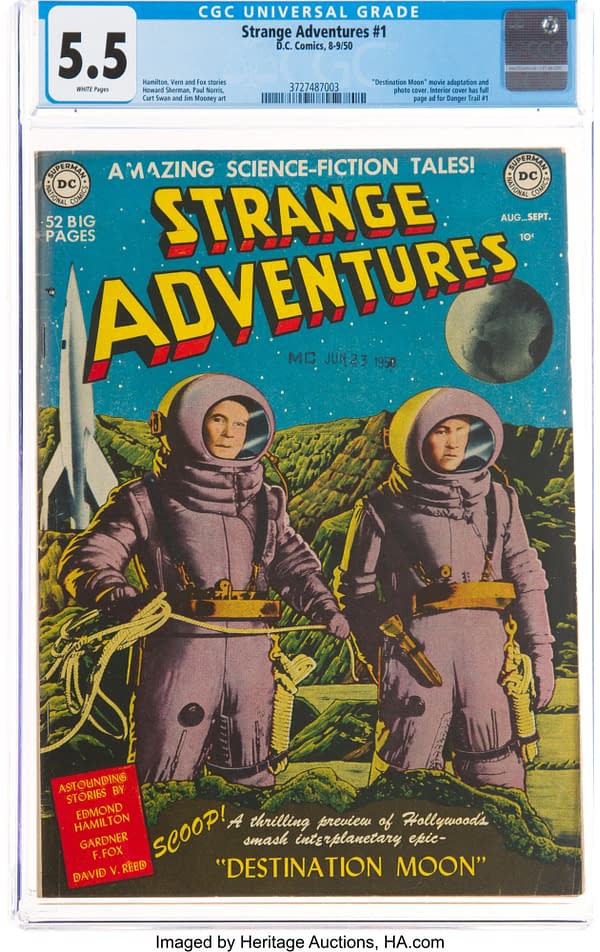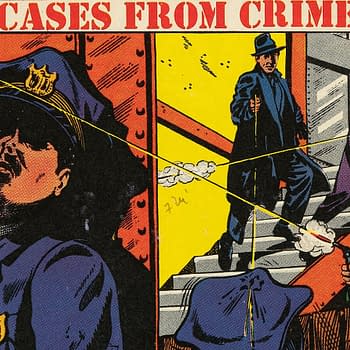Posted in: Comics, Heritage Sponsored, Sponsored, Vintage Paper | Tagged: dc comics, destination moon, strange adventures
The Strange Story Behind 1950's Strange Adventures #1 from DC Comics
The historically important DC Comics series Strange Adventures was launched in 1950 and ran for 244 issues before ending in 1973. The title introduced a number of well-remembered DC Comics characters over the years, including Captain Comet, Animal Man, and Deadman. Largely remembered as one of a number of 1950s comic book titles during this early Cold War era that featured weird science fiction, the debut of the series also included a healthy dose of science fiction history while remaining a fascinating artifact of what is known as comics' Atomic Age. There's a copy of the debut of a long-running and historic DC Comics series in Strange Adventures #1 CGC 5.5 up for auction in today's session of the 2021 April 18-19 Sunday & Monday Comics, Animation & Art Weekly Online Auction #122116 from Heritage Auctions.

While Strange Adventures #1 contains ten stories (comics and/or text), it's the eight-page cover-feature Destination Moon which is of the most historical interest here. The story based on the Robert Heinlein film script (in turn based on some of Heinlein's prior work) was adapted for DC Comics by Gardner Fox and Curt Swan. Destination Moon is considered a seminal moment in science fiction cinema history, setting the tone for more serious and realistic portrayals of such subject matter for the subsequent decades.
There are several moments in the film that catch my particular attention as a student of Cold War-era propaganda in entertainment, beginning with this meta-commentary on the type of propaganda which would rapidly become a hallmark of the 1950s and 1960s:
Dr. Charles Cargraves : You can't buck public opinion; I've tried. Have you seen this?
[Newspaper headline: MASS MEETING PROTESTS RADIOACTIVE ROCKET]
General Thayer : That isn't public opinion – it's a job of propaganda!
Jim Barnes : You're almighty right it is. Manufactured and organized – with money and brains. Somebody's out to get us.
We discussed similar propaganda meta-commentary as part of the storyline in a piece on the 1955 film Artists and Models, a likely influence on the debut of Batwoman in Detective Comics #233. But in the case of Destination Moon, the film not only comments on the impact of propaganda but is likely propaganda itself. Another scene from the movie is seemingly a tell [emphasis mine]:
Jim Barnes : Here's the reason. The vast amount of brains, talents, special skills, and research facilities necessary for this project are not in the government, nor can they be mobilized by the government in peacetime without fatal delay. Only American industry can do this job. And American industry must get to work, now, just as we did in the last war!
Industrialist : Yes, but the government footed the bill!
Jim Barnes : And they'll foot this bill, too, if we're successful; you know that. If we fail, we'll take a colossal beating. So we can't fail! Not only is this the greatest adventure awaiting mankind, but it's the greatest challenge ever hurled at American industry. And General Thayer is going to tell you why.
General Thayer : The reason is quite simple. We are not the only ones who know that the Moon can be reached. We're not the only ones who are planning to go there. The race is on – and we'd better win it, because there is absolutely no way to stop an attack from outer space. The first country that can use the Moon for the launching of missiles… will control the Earth. That, gentlemen, is the most important military fact of this century.
Not only does this signal the start of the space race between the U.S. and the Soviet Union, but it also echoes one of the concerns explicitly referenced in NSC-68, the United States' foundational Cold War document which was authored just months before Destination Moon hit theaters: it is far more difficult to convince the American public of the necessity of major military spending over a sustained period during peacetime. The public has to be persuaded. Of course, this is as true today as it was in 1950.
Diving into that background even deeper, we find that this purpose is in large part influenced by Destination Moon creator and giant of American science fiction Robert A. Heinlein. A graduate of the United States Naval Academy who had ties to Naval Intelligence during World War II, Heinlein began making efforts to get the Navy interested in rocketry and spaceflight around the end of the war: (note: Paul Gilster's deep dive on the background of Destination Moon is a must-read):
With the end of World War II, Heinlein began to develop a close interest in rockets and atomic power. He made it a personal campaign at the end of 1945 and beginning of 1946 to get the Navy interested in rockets [2, 3]. The advent of the large rocket, the V2, was on Lang's mind too; he talked to Ley about making another movie about a spaceship to the Moon. Ley put Lang in touch with Heinlein. Lang invited the Heinleins for dinner often in 1946 and 1947. During those years. Lang and Heinlein talked about a lot of things, Heinlein was reluctant to start writing young adult novels, but Lang convinced Heinlein it would be an excellent way to connect with an audience that had an appetite for space flight.
Fascinatingly, Strange Adventures #1 is one of two major comic book adaptations of the movie which would appear in 1950. Strange Adventures #1 would hit the newsstands in June 1950, as sort of a short preview ahead of the film's early August opening. Then, hitting the stands in September, Fawcett Comics would publish a more complete adaptation. Curiously, perhaps influenced by the massive advance publicity for the film, legendary comics creator Hergé would publish his own tale of a trip to the moon in Tintin Magazine March 30, 1950 – September 7, 1950, itself called Destination Moon.
Just how massive was the publicity for Destination Moon? The production garnered frequent notices as early as August 1949, and grew to include an impressive marketing blitz across all media — as conveniently explained by Woody Woodpecker in a short commissioned for inclusion in the film itself:
A fascinating artifact of both science fiction and cold war political history, Strange Adventures #1 also represents a key turning point in the history of DC Comics itself. There's a copy of the debut of a long-running and historic DC Comics series in Strange Adventures #1 CGC 5.5 up for auction in today's session of the 2021 April 18-19 Sunday & Monday Comics, Animation & Art Weekly Online Auction #122116 from Heritage Auctions.

Strange Adventures #1 (DC, 1950) CGC FN- 5.5 White pages. Adapts the feature film Destination Moon. Photo cover. First Chris KL-99 story. Dick Sprang, Curt Swan, and Jim Mooney art. Currently #3 on Overstreet's Top Ten Sci-Fi Comics list. Overstreet 2020 FN 6.0 value = $543. CGC census 4/21: 15 in 5.5, 63 higher.
View the certification for CGC Certification ID 3727487003 and purchase grader's notes if available.

















